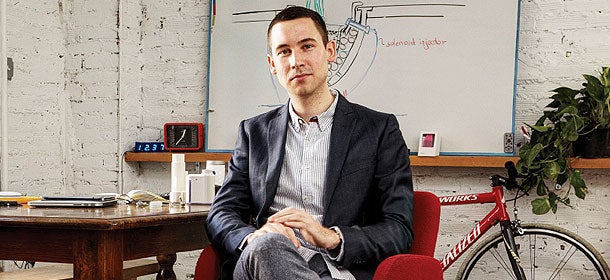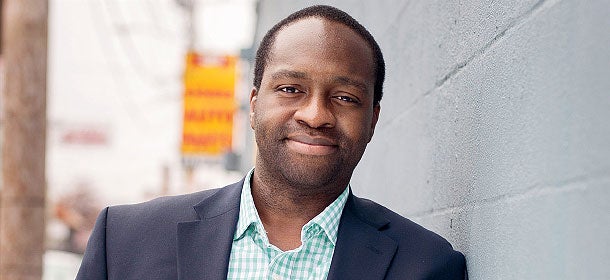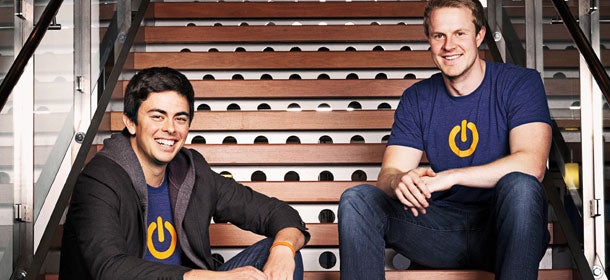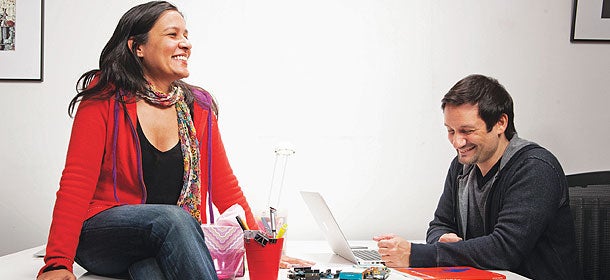Technological innovation is revolutionizing every sector of industry--even areas such as fashion design, pharmaceuticals and cash payments that historically have had little association with the digital world. In addition to modernizing processes, these advancements are bucking the traditional ways of doing business by solving real-world issues, driving down barriers to entry and empowering the little guy.
Meet some of the problem-solvers whose new ideas are leading the way.
Product Design
 Know your product: Engineer Ted Ullrich. Photo (C) Ewan Burns The Shape-maker
Know your product: Engineer Ted Ullrich. Photo (C) Ewan Burns The Shape-maker
Tomorrow Lab brings startups' concepts to life through smart, sleek design
Apple has product designer Jonathan Ive to take its complex technology and turn it into easy-to-use, lust-worthy products such as the iPhone and iPad. Startups in search of venture capital or Kickstarter funding have Tomorrow Lab.
Through his New York City-based design and engineering firm, engineer Ted Ullrich, along with partners Pepin Gelardi and Dean DiPietro, is out to codify the process of creating successful products. Their goal is to streamline the process to the point where Apple-quality work filters down to cash-strapped tech entrepreneurs who have an idea for a product but no idea of how to make it or what it could look like.
That's what happened with one of Tomorrow Lab 's first wins, a "smart" electronic pill bottle developed for AdhereTech in 2013. The bottle not only senses whether patients have taken their meds, it also alerts them to do so via phone call or text and sends updates to healthcare providers wirelessly.
"Basically, we came to Tomorrow Lab with an ugly prototype of an orange pill bottle with some wires," says Josh Stein, CEO at New York-based AdhereTech.
- Product Design, The Shape-maker
- Pharmaceuticals, Drug Enforcement
- Venture Capital, Currency Kings
- Fashion, Crowd Couture
- Mobile, Raise Money Anywhere
- Programming, The Device Code
"They turned that into a beautiful, award-winning product that medical professionals immediately understood and started to use." That success cemented Tomorrow Lab's reputation for taking clients' concepts and creating slick products that elevate their core functionality through technology--and doing so on the cheap. To wit: The Lab's sleek solution for the Buca Boot, a locking trunk for bicycles, pulled in $90,883 on Kickstarter in October.
"They've carved out a niche working with startups," says Haytham Elhawary, director of the Zahn Center for Entrepreneurship at City College of New York's Grove School of Engineering in New York City. "They have a great command on how to get things manufactured at a small- to medium-volume scale."
The killer combination of technological prowess, sophisticated design aesthetic and manufacturing know-how explains how this trio is shaking up the product-development world. But DiPietro claims it's simpler than that. "We are a design firm made up of engineers," he says. "Our passion is in objects and tinkering and hacking to make things work, and we also know that good design is part of the solution." --Jonathan Blum
Pharmaceuticals
 Med check: Ashifi Gogo keeps it real. Photo (C) Jared Leeds Drug Enforcement
Med check: Ashifi Gogo keeps it real. Photo (C) Jared Leeds Drug Enforcement
An engineer puts up a high-tech fight against fake products
Saving consumers money isn't nearly enough to satisfy Ashifi Gogo. He has set his sights on something far bigger: saving consumers' lives. Gogo is the engineering mastermind behind the Mobile Product Authentication (MPA) solution from Cambridge, Mass.-based Sproxil. MPA enables shoppers to determine whether retail goods are legitimate, counterfeit or stolen using any mobile phone. Consumers simply scratch off the Sproxil security label affixed to an item at the factory to reveal a one-time-use numeric code, then text the code for free to a secure number to authenticate the product's origins.
While the MPA technology workswith any tangible product, Sproxil is focusing its efforts on the international pharmaceutical market. According to the World Health Organization, up to 30 percent of drugs sold in emerging nations in Africa, Asia and Latin America are counterfeit.
- Product Design, The Shape-maker
- Pharmaceuticals, Drug Enforcement
- Venture Capital, Currency Kings
- Fashion, Crowd Couture
- Mobile, Raise Money Anywhere
- Programming, The Device Code
"Counterfeiting is such a huge problem," says Gogo, a native of Ghana who founded Sproxil in 2008 and serves as its CEO. "We've made a commitment to impact the lives of hundreds of millions of consumers in markets where people have no other means to verify the products they buy."
Gogo first encountered counterfeiting as a teen, sizing up knockoff Nintendo game consoles stocked on retailer shelves alongside the real deal. "The copycat consoles were sold at a much lower cost, but consumers had no real assurance they would work," he recalls.
He learned about West Africa's counterfeit drug epidemic while at the Thayer School of Engineering at Dartmouth College; his Ph.D. research eventually yielded an embryonic version of the MPA service. Initially Gogo thought his technology would gain traction in the foodie market, applied to organic produce. However, "nobody wanted it," he admits. "Retailers felt it was irrelevant, and consumers agreed. They said, 'If Whole Foods says it's organic, then it's organic.'"
Sproxil enjoyed a much warmer welcome from the pharmaceutical sector, where legitimate manufacturers were scrambling to identify a user-friendly method to differentiate their products from counterfeit medications. Sproxil now sells the MPA solution directly to pharmaceutical companies and other brand owners, supplying coded labels (or simply the codes, if the manufacturers control their own printing facilities) and overseeing product verification on its servers.
In addition to pharmaceutical products, Sproxil labels are attached to everything from apparel to automotive parts to copper wiring. There are 3.5 million unique users across the Sproxil platform, with verifications approaching 6.3 million at press time. Gogo declines to provide figures but says sales are doubling year over year. Additionally, the firm has secured a $1.8 million investment from Acumen, a nonprofit global venture fund addressing international poverty.
"Counterfeiters better watch out," Gogo says with a laugh. "They may be forced to look for new careers soon." --Jason Ankeny
Venture Capital
 They're so money: Adam Draper (left) and Brayton Williams. Photo (C) Cody Pickens Currency Kings
They're so money: Adam Draper (left) and Brayton Williams. Photo (C) Cody Pickens Currency Kings
Boost VC bets big on Bitcoin
If Adam Draper has his way, servicing the controversial Bitcoin currency--a digital form of money that's not tied to any country or government--will become a mainstream, worldwide industry. "We're a global economy now, but there's no one traditional currency that ties the world together," Draper says. "Bitcoin transcends the others because it crosses borders seamlessly."
Bitcoin's value skyrocketed in 2013, with its use spreading around the world and spawning a $5 billion economy.
Although the lack of jurisdiction over Bitcoin and its links to money laundering and illicit marketplaces have raised more than a few eyebrows, the currency offers a simple way for legitimate businesses such as small retailers and professional service providers to accept payments for international sales without facing onerous credit card fees or exchange-rate surcharges.
- Product Design, The Shape-maker
- Pharmaceuticals, Drug Enforcement
- Venture Capital, Currency Kings
- Fashion, Crowd Couture
- Mobile, Raise Money Anywhere
- Programming, The Device Code
To facilitate those transactions, Draper co-founded and serves as CEO of Boost VC, a 12-week accelerator program in San Mateo, Calif., that offers housing, office space and mentoring to early-stage startups with a focus on Bitcoin-related businesses.
Among recent Boost graduates that have attracted investors' attention are Gliph, an app for secure texting and Bitcoin payments, and VerifyBTC, real-time ID software for Bitcoin transactions. Two sexier, consumer-focused Bitcoin startups Draper likes to showcase are BitPagos, a payment processer for hotels in Argentina that lets them keep money in Bitcoins instead of exposing it to the country's crippling inflation rate, and BitWall, which lets digital publishers charge per-article micropayments to readers and avoid costly credit card transaction fees.
Draper caught the Bitcoin bug in 2012 after a conversation with Brian Armstrong, co-founder of Coinbase, a virtual wallet for the currency. Draper also liked that Bitcoin had already bounced back and then some from a computer hack and the following sell-off that almost wiped out the currency in 2011. The value of one Bitcoin soared past the $1,000 mark by December. "People wanted Bitcoin to live so much, they basically willed it back into existence," he says. "That showed me how passionate this community was about it."
With Federal officials testifying to Congress last November that despite its darker uses, the online currency has real-life benefits for lubricating global financial systems, the future appears bright for Bitcoin--and the companies Draper plans to build up around it. "Bitcoin is the best-performing asset in the world right now," he says. "I want to do my part in supporting this huge revolution in currency." --Vanessa Richardson
Fashion
 Democratizing duds: Charlotte Genevier. Photo (C) Julia Vandenoever Crowd Couture
Democratizing duds: Charlotte Genevier. Photo (C) Julia Vandenoever Crowd Couture
The Cotery's digital system turns anyone into a designer
Say you're a teenager in Oklahoma with an idea for a cute shirt. You stitch one together but then have no idea what to do next. Until recently, you'd make the rounds of stores and store buyers with your sample, track down and order fabric, hire a factory to make the shirts and a distributor to deliver them. And then you'd wait (and wait) to get paid.
These days, fashionistas can post their designs on The Cotery, a Boulder, Colo.-based hybrid crowdfunding site, online store and back-end logistics-management tool. "There's an astounding number of people who want to be clothing designers but don't know how," says Charlotte Genevier, a software developer who started programming at age 12 and launched The Cotery in 2013.
On the site, newbie designers can test out their wares by posting sample garments in their own mini-stores. If a piece sells at least 200 units, The Cotery's back-end operation springs into action, handling preorder payments from customers, sourcing fabric, contracting with garment factories to sew the orders and shipping the finished products to buyers.
- Product Design, The Shape-maker
- Pharmaceuticals, Drug Enforcement
- Venture Capital, Currency Kings
- Fashion, Crowd Couture
- Mobile, Raise Money Anywhere
- Programming, The Device Code
In return, The Cotery takes a portion of each sale to cover manufacturing, fulfillment and profit margin and distributes the remainder to the designer. If a garment turns out to be a hit, the manufacturing fee decreases. Even better: Since production runs are limited to the number of presales, there's no waste and no excess inventory to mark down due to tepid demand. All the designers have to do is design.
As for the perceived barrier to selling clothes online because customers aren't able to try on the garments, the buying public appears to see none. Indeed, The Cotery is poised to ride the wave of online apparel and accessories sales nationwide that's seeing nearly 16 percent annual growth and is expected to reach sales of $56.6 billion in 2014, according to research company eMarketer.
Numbers aside, what drives Genevier's belief in The Cotery is the power of fashion. "Whether you want to show off your creativity, your professionalism or your identification with a particular social group," she says, "clothing is the easiest way to do it." --Joe Lindsey
Mobile
 Daily bread: James Beshara (left) and Khaled Hussein make crowdfunding routine. Photo (C) Justin Keena Raise Money Anywhere
Daily bread: James Beshara (left) and Khaled Hussein make crowdfunding routine. Photo (C) Justin Keena Raise Money Anywhere
Crowdtilt brings crowdfunding to everyone's phone
To James Beshara and Khaled Hussein, founders of San Francisco-based Crowdtilt, the future looks something like this: A Mumbai taxi driver sitting in a queue at the airport dreams of owning his own cab. From the driver's seat, he opens the Crowdtilt app on his smartphone and sets up a crowdfunding campaign. He uses his phone to market and manage the campaign and, at the end, process any money received.
As Beshara and Hussein see it, crowdfunding's next step is to go mobile and global. According to Beshara, more than a third of Americans use their phones as their primary internet device, and that number is growing. Crowdtilt's app, which rolled out in September, is currently the only one that allows users to launch and manage a crowdfunding campaign directly from a smartphone or tablet.
But adoption by the rest of the planet is only part of the game for Beshara and Hussein. What they really want is the integration of crowdfunding into daily life. "With our app, it's not just about allowing you to crowdfund your artistic project on your commute home," Beshara says. "It's about taking something that you might do two or three times a year and making it something you might do two or three times a week."
- Product Design, The Shape-maker
- Pharmaceuticals, Drug Enforcement
- Venture Capital, Currency Kings
- Fashion, Crowd Couture
- Mobile, Raise Money Anywhere
- Programming, The Device Code
That's not far off. Soon after Crowdtilt's launch as a way to fund charitable causes, it caught the attention of startups looking for a cheaper alternative to the more popular--and expensive--Kickstarter and Indiegogo options. (Crowdtilt takes 2.5 percent of funds raised, vs. Kickstarter's 5 percent.) Not content to compete only on price and easy access, last August the duo launched Crowdhoster, a free online tool that leverages Crowdtilt's open API software to allow anyone from a mom-and-pop operation to a large corporation to add crowdfunding to their own website within minutes.
As for Crowdtilt's competition, Beshara has an idea of what might happen to rivals who keep their technology closed and walled off. "The novelty is wearing off for Kickstarter; it's definitely not an open and accessible approach to crowdfunding," he says. "When you have not democratized or opened up your platform to let people use it the way they want, you usually do not last as long as you originally set out to." --Daniel Dumas
Programming
 Daily bread: James Beshara (left) and Khaled Hussein make crowdfunding routine. Photo (C) Ewan Burns The Device Code
Daily bread: James Beshara (left) and Khaled Hussein make crowdfunding routine. Photo (C) Ewan Burns The Device Code
Developing smart networks: Trisala Chandaria (left) and Jean-Baptiste Leonelli.
Trisala Chandaria and Jean-Baptiste Leonelli knew they wanted to democratize programming, making it simple and efficient for app developers to create and update code. That's why in 2012 they launched New York City-based Temboo, a repository of programming processes that developers can use to connect to code utilities, databases and more than 100 application programming interfaces (APIs) for online services ranging from Amazon Web Services cloud storage to real-estate site Zillow.
Available in seven programming languages, Temboo's platform lets coders access a cloud-based library of more than 2,000 snippets of code, or "choreos" (short for choreographies), that they can insert into their projects. Whether they want to enable an app to copy files to Dropbox or check payments via PayPal, incorporating choreos can turn the once-lengthy process into short, five-line pieces of code. As a result, programmers get tidier software. And when an online service makes a change to its API, Temboo adjusts the code on the back end--a huge time-saver that eliminates one of the biggest headaches for developers: constant updates.
- Product Design, The Shape-maker
- Pharmaceuticals, Drug Enforcement
- Venture Capital, Currency Kings
- Fashion, Crowd Couture
- Mobile, Raise Money Anywhere
- Programming, The Device Code
But Temboo goes even further. In May 2013, the company made the leap from software to hardware, announcing a partnership with Italy-based Arduino, a manufacturer of open-source microcontroller hardware boards popular with makers, hobbyists and designers. Embedded in the Wi-Fi-equipped Arduino Y?n circuit board, Temboo now enables hardware-based processes. Chandaria says hobbyists have programmed their Y?ns to manage everything from Twitter-connected home security computers to electricity usage meters that automatically log values onto a Google spreadsheet. It's a key development in the new range of "smart" networked devices, the so-called Internet of Things.
"With this little hook into our cloud, these dumb devices become incredibly intelligent, flexible and also really easy to program," says Vaughn Shinall, who works in product outreach for Temboo.
Programming hardware typically requires advanced skills, and microcontrollers like the Y?n--with no screen, limited RAM and low power--can be especially tricky to code. But by employing Temboo's virtualized code, developers can program the device easily and quickly. "For an Arduino user, from the time of sign-up to the time of successfully running their first choreo with Temboo--we've seen that done in about eight minutes," Chandaria says.
"Well-funded" by private investment (Chandaria declines to reveal figures about financing, user base or revenue), Temboo has enterprise clients including U.K.-based food chain Eat and a major U.S. financial institution.
With licensing plans that range from free for distributing up to 1,000 choreos per month to $299 for 250,000 per month, the company appears equipped to handle the load as its service increases in popularity.
Since the Arduino announcement, that user base has grown exponentially, Chandaria claims. "If you want an Internet of Things that is connected--that is supposed to bring all the parts together--one of the challenges is having programming capability for these devices that is easy, has a low threshold and is updatable," she says. "The solution we've built is a really nice fit for that." --John Patrick Pullen